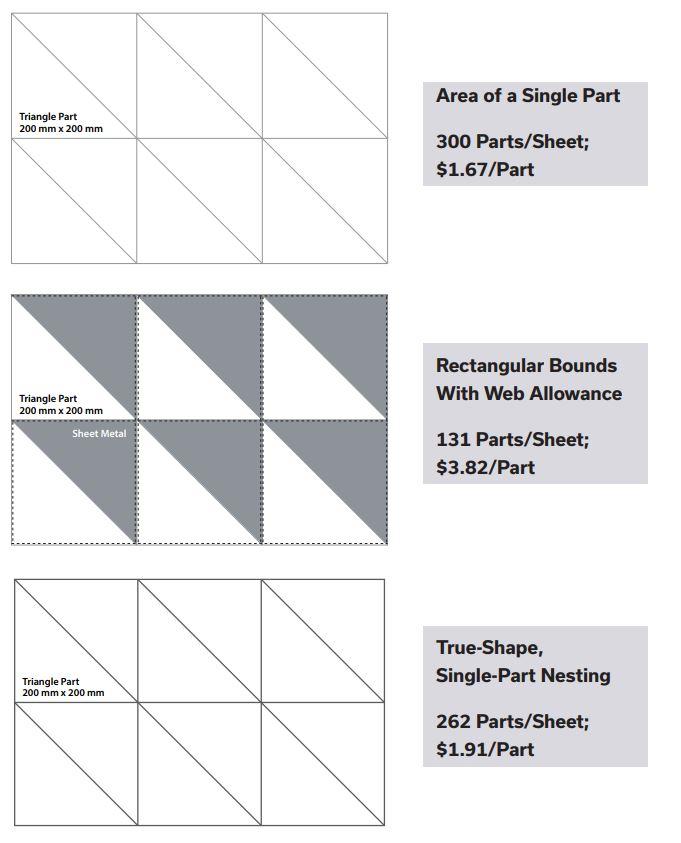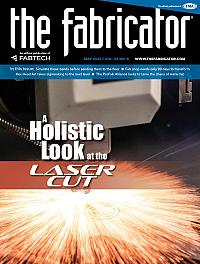Director
- FMA
- The Fabricator
- FABTECH
- Canadian Metalworking
Categories
- Additive Manufacturing
- Aluminum Welding
- Arc Welding
- Assembly and Joining
- Automation and Robotics
- Bending and Forming
- Consumables
- Cutting and Weld Prep
- Electric Vehicles
- En Español
- Finishing
- Hydroforming
- Laser Cutting
- Laser Welding
- Machining
- Manufacturing Software
- Materials Handling
- Metals/Materials
- Oxyfuel Cutting
- Plasma Cutting
- Power Tools
- Punching and Other Holemaking
- Roll Forming
- Safety
- Sawing
- Shearing
- Shop Management
- Testing and Measuring
- Tube and Pipe Fabrication
- Tube and Pipe Production
- Waterjet Cutting
Industry Directory
Webcasts
Podcasts
FAB 40
Advertise
Subscribe
Account Login
Search
Accurate quotes maximize a fabrication shop's profits on laser cutting jobs
Avoid these 4 pitfalls and improve customer satisfaction with advanced quoting systems
- By Felipe Lechuga
- May 31, 2023
- Article
- Manufacturing Software

If you don’t have the right quoting system to maximize your laser cutting job shop’s profitability, you can end up with a messy process, and some jobs could cost you more than the money they bring in.Dan Comaniciu / iStock / Getty Images Plus
The laser cutting industry is a complex one to master, especially when it comes to quoting jobs. Profitability can be difficult to achieve in a job shop if you’re working with an inadequate quoting system.
Avoiding some common pitfalls can help both new startups and longstanding shops formulate accurate quotes for better profits and happier customers.
1. Changing Material Prices
Material prices are always changing, and you’ll need to adjust your quotes to match them. If you’re quoting a job based on an old part price and your supplier varies the price of materials, you could end up losing money on the job—or charge too high a price for the market and lose customers. It’s a fine line to tread.
Staying informed of the latest material prices can be challenging, especially in this time of volatile markets and supply chain issues.
2. Inexperienced Quote Preparers
It’s not uncommon in job shops for customer service staff to prepare quotes. Often, however, they don’t have the experience to know how long different processes will take, from welding to bending to folding to laser cutting. So, they head out to the shop floor to ask each specialist how long tasks will take. These specialists (usually some of the higher-paid staff) then take time away from their work to answer questions or run simulations to determine accurate times.
It’s also not uncommon for two different customer service reps within the same business to quote two different prices to a customer. The customer then loses confidence in the pricing and decides to verify it by obtaining a quote from a competing supplier.
3. Calculating Material Consumption
A recent survey of 100 of our customers worldwide showed that over a two-year period, 56% of revenue in laser job shops was derived from the sale of material. Calculating how much material your shop consumes in a month is complicated and depends on the value of your material in work-in-process, full sheets in inventory, and material remnants you are holding.
It’s crucial to consider material wastage in your part price calculations, or you could lose money on jobs. Most cutting jobs produce a significant amount of scrap, and even with an optimal setup, some material will always be wasted. The key is to set up your pricing correctly so that your customers are contributing.
There are three common methods for calculating material consumption—and therefore part price—and each creates a different result:
- Area of a single part – The area of the part (the part itself, not the bounds) is calculated and then divided into the sheet. It doesn't allow for any web, and in most cases, it gives a lower price per part than the material consumed.
- Rectangular bounds with web allowance - The rectangular boundary around the part is larger than the part itself, which ensures you are charging for all the material you use. However, this method calculates a larger percentage of scrap into the part price, so your material cost will be higher than that of your competitors using other methods, and you’ll win fewer quotes.
- True-shape, single-part nesting – This method lets you determine how many copies of a single part can be cut from a single sheet while also allowing you to decide how to price any remnant associated with the calculated sheet.
Take, for example, a triangular part with a 100-mm base, 300-mm apex, and 10-mm thickness. Triangles are used here to represent complex, nonrectangular shapes, although they are simple to nest and price. Based on a 3,000- by 1,500-mm sheet priced at $500, the three different costing methods give three very different results (see Figure 1):

FIGURE 1. Based on a 3,000- by 1,500-mm sheet priced at $500, the three different costing methods give three very different results.
- Area of a single part: 300 parts/sheet, $1.67/part – With zero allowance for web and scrap, you will likely lose money on the material component of your quote unless you add a significant markup.
- Rectangular bounds with web allowance: 131 parts/sheet, $3.82/part – You will be unlikely to win any work with this method.
- True-shape, single-part nesting: 262 parts/sheet, $1.91/part – This is closest to what you will actually achieve in production and is the safest, most competitive method.
These variations may not be significant for low-quantity jobs, but if you consider that an average laser cutting machine can generate more than $1 million in material revenues in a year, you are looking at potential lost revenue opportunities from $50,000 to $150,000, depending on which material nesting you select for your quotations.
As these results show, it does not make sense at the quoting stage to use multipart nesting, because you do not know the final mix of parts to be cut, so you cannot be certain you are calculating the optimal price. True-shape, single-part nesting is an effective way to calculate price, as it rotates and interleaves parts to make the best nest, with a close approximation to the CAM system that you’ll actually be cutting the parts with.
4. Different Cutting Times for Different Shapes
A CAM system will calculate cutting times based on the geometry to be cut, but if you compare a square plate to a circle with the exact same cut length, the circle will be quicker for the machine to cut, because the laser mechanical system does not need to slow down when changing directions.
It’s easy to overlook these differences when quoting, but every second of laser cutting time lost is revenue lost.
Make Your Quoting System Work for You
With these and other pitfalls to avoid, getting the right system in place that gives you accurate, repeatable laser cutting quotes is crucial to your job shop’s ongoing success and profitability. Many of the challenges and errors associated with quoting a laser cutting job result from manual preparation; data can be complicated and difficult to process, and people make mistakes.
One option is to use rules-based quoting software designed specifically for job shops. Whether supplying current material prices, accounting for secondary processes on the shop floor, determining the most profitable nesting layout, or using built-in algorithms that take care of acceleration and deceleration tolerances, this type of software can automate the process and help ensure quoting accuracy, consistency, and efficiency. That means you can respond more quickly and confidently to RFQs, which could help you win the business.
Using our own data of more than 1 million cut parts, we found that an average quote incorporates 5.5 parts. The industry average to quote 5.5 parts is approximately 30 minutes. Quoting software can reduce that time to just two minutes—15 times faster than the industry average—and it’s repeatable every time.
About the Author
Related Companies
subscribe now

The Fabricator is North America's leading magazine for the metal forming and fabricating industry. The magazine delivers the news, technical articles, and case histories that enable fabricators to do their jobs more efficiently. The Fabricator has served the industry since 1970.
start your free subscription- Stay connected from anywhere

Easily access valuable industry resources now with full access to the digital edition of The Fabricator.

Easily access valuable industry resources now with full access to the digital edition of The Welder.

Easily access valuable industry resources now with full access to the digital edition of The Tube and Pipe Journal.
- Podcasting
- Podcast:
- The Fabricator Podcast
- Published:
- 04/16/2024
- Running Time:
- 63:29
In this episode of The Fabricator Podcast, Caleb Chamberlain, co-founder and CEO of OSH Cut, discusses his company’s...
- Trending Articles
Tips for creating sheet metal tubes with perforations

JM Steel triples capacity for solar energy projects at Pennsylvania facility

Are two heads better than one in fiber laser cutting?

Supporting the metal fabricating industry through FMA

Omco Solar opens second Alabama manufacturing facility

- Industry Events
16th Annual Safety Conference
- April 30 - May 1, 2024
- Elgin,
Pipe and Tube Conference
- May 21 - 22, 2024
- Omaha, NE
World-Class Roll Forming Workshop
- June 5 - 6, 2024
- Louisville, KY
Advanced Laser Application Workshop
- June 25 - 27, 2024
- Novi, MI


























